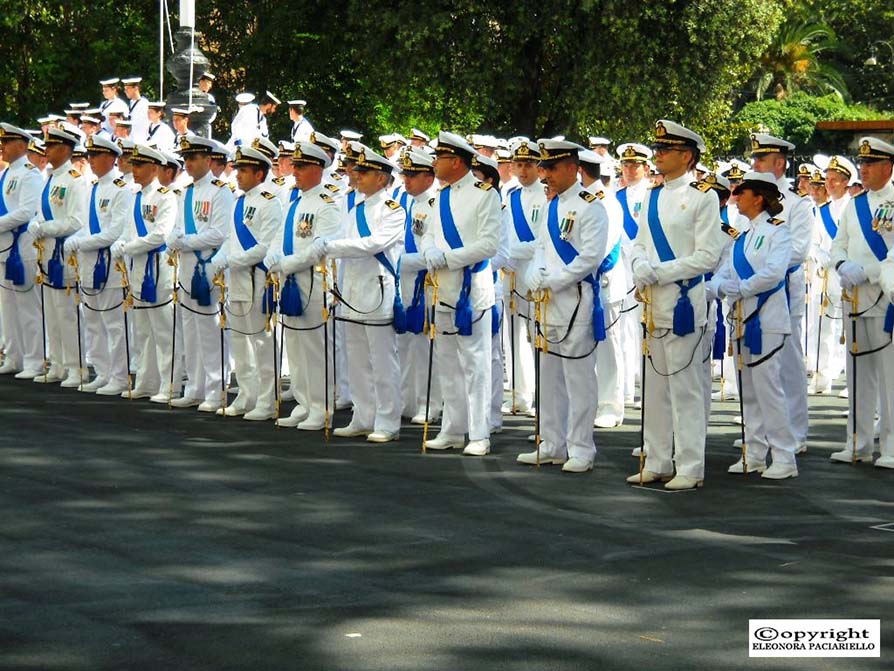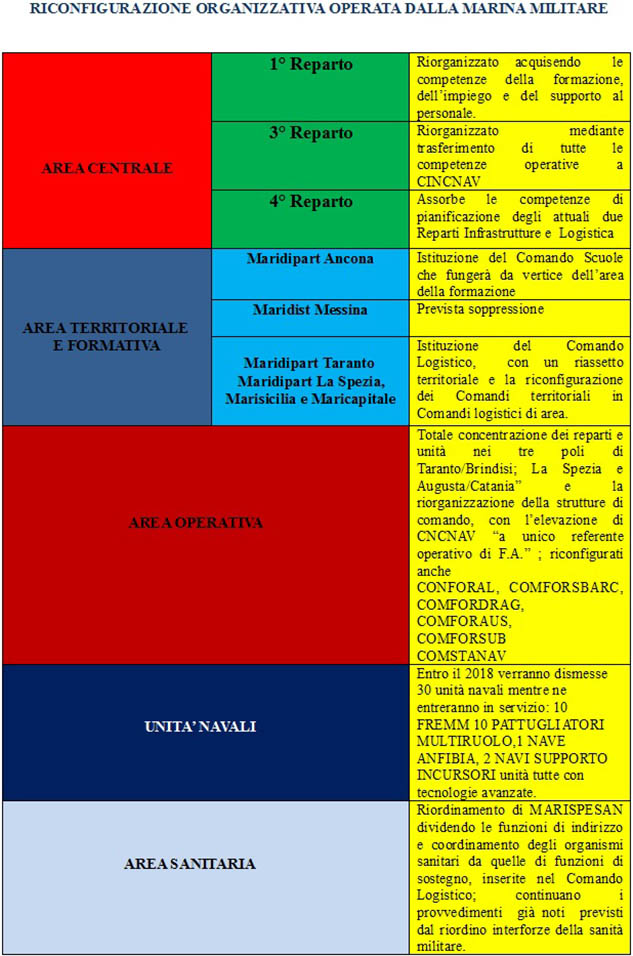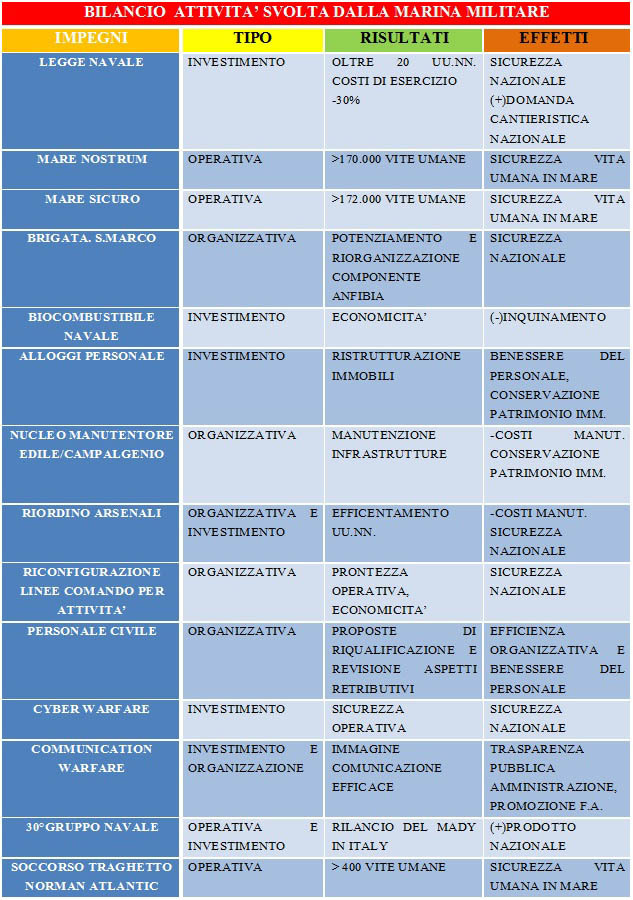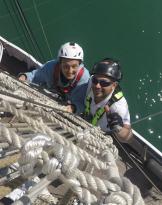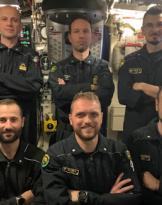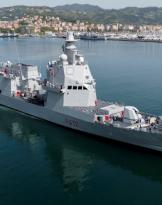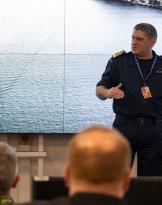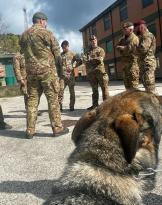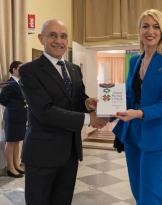22 June 2016, the Navy changes its chief of staff, after more than three years of intense activity the amm. Giuseppe De Giorgi and the amm. Walter Girardelli, who finds himself in command of an armed force deeply renewed in his image, in his role, in his organization and functions, which have profoundly changed the traditional characteristics, raising both consensus but sometimes also targeted criticism. But in addition to conflicting aspects and different positions of thought, the Marina has lived in recent years in a historical context characterized by heavy budgetary constraints, reduction in the operational capacity of naval force, reduction of the military instrument, substantial geopolitical changes in the Mediterranean, emergence of the difficult migration phenomenon. Nevertheless, the Armed Forces have been able to re-emerge with various strategies with a new organizational form and a renewed operational capacity.
The analysis of change
To understand the reasons for this change, it is necessary to retrace some fundamental steps that started a few years ago, when the attention shifted to the reduction of the armed forces between the military and civilian personnel, after the lively debate that had arisen in the national context for the restructuring of the defense sector with the delegation to the government for the revision of the national military instrument through the 31 law December 2012, n. 244. Specifically, the revision proposed by the government was intended to achieve, in a medium-term view, the following objectives:
-
improving the qualitative and technological level of the national military instrument, fully interoperable and interacting with the defense and security system of the European Union and the Atlantic Alliance;
-
optimal allocation of the resources assigned to the "defense function" among the various items of expenditure (personnel, operations, investments), in harmony with European standards and with the reduced resources assigned to the defense sector.
These two goals encompass a series of important actions that, between decisions taken and future intentions, are profoundly transforming our armed forces, which in this area can find the opportunity to modernize a fundamental sector of the State, becoming for the typicality and the extreme correlation with the socio-economic sector of the country, a new topic of technical and legal study of great scientific interest and certainly to be deepened.
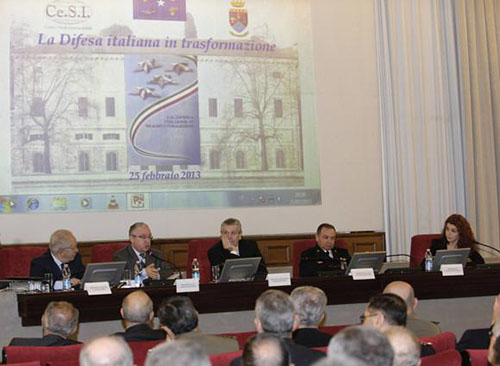 "The Italian Defense in transformation"Was the title of the volume presented on 25 February 2013 at the Center for Advanced Defense Studies (CASD) and produced by the Center for International Studies (Ce.SI) but also a strong sign of change, in the presence of the Minister of Defense Admiral Giampaolo Di Paola, team admiral Rinaldo Veri (president of the CASD), and other important personalities. Minister Di Paola did not fail to highlight the essentiality for Italy to implement a revision of the Military Instrument which, in relation to the available resources, guarantees military efficiency for peace and for the maintenance of national security and international stability, in a an integrated perspective in the systems of the Atlantic Alliance and the European Union, to “continue to play an active, credible and responsible role on the international scene”. The same line of continuity was indicated by Admiral Luigi Binelli Mantelli, then Chief of Defense Staff and former Navy Chief of Staff who specified the three essential guidelines to achieve the objectives indicated: 1) the operation in a joint and multinational sense, as a capital fueled by training and by keeping the means efficient; 2) theintegration interdisciplinary with all the realities and dicasteries that contribute to the national security and defense system and beyond; 3) identity to the roles of each individual Armed Forces: professionalism, motivation and cohesion, in their peculiarities, because they are rich in traditional values, and moral resources to face present and future. In summary, a mix of technology, organization and professionalism to face the challenge in progress. In fact, Admiral Binelli Mantelli had pointed out by CSM how MM has changed in its ability to compete for joint forces, in international missions, with full integration between the various components. In the FA a change was activated that mainly involved the operating tool, the training structures, the mentality of the cadres, according to the logic of the TQM (total quality method), which the admiral himself considers among the most suitable to a structure that must change while continuing to operate. Action is therefore necessary breakthrough, when an organization approaches unsustainable situations, a deeper restructuring is needed to lay the foundations for a solid recovery in productivity and efficiency. The role of the Navy must therefore be seen not only as a "producer" of security, but also as a growth factor and "catalyst" of financial flows that contribute to the formation of the gross domestic product. Not only protection and protection of our interests on the sea, but also dialogue, international cooperation and promotional activities for the national defense industry and the "made in Italy" in the world, so that our ships represent a "technology business card and Italian efficiency ”. The public contribution for military spending must therefore be considered as a factor of return on investment (Return on Investment), improving the credibility of the country that supports international missions for the stabilization and pacification of crisis areas.
"The Italian Defense in transformation"Was the title of the volume presented on 25 February 2013 at the Center for Advanced Defense Studies (CASD) and produced by the Center for International Studies (Ce.SI) but also a strong sign of change, in the presence of the Minister of Defense Admiral Giampaolo Di Paola, team admiral Rinaldo Veri (president of the CASD), and other important personalities. Minister Di Paola did not fail to highlight the essentiality for Italy to implement a revision of the Military Instrument which, in relation to the available resources, guarantees military efficiency for peace and for the maintenance of national security and international stability, in a an integrated perspective in the systems of the Atlantic Alliance and the European Union, to “continue to play an active, credible and responsible role on the international scene”. The same line of continuity was indicated by Admiral Luigi Binelli Mantelli, then Chief of Defense Staff and former Navy Chief of Staff who specified the three essential guidelines to achieve the objectives indicated: 1) the operation in a joint and multinational sense, as a capital fueled by training and by keeping the means efficient; 2) theintegration interdisciplinary with all the realities and dicasteries that contribute to the national security and defense system and beyond; 3) identity to the roles of each individual Armed Forces: professionalism, motivation and cohesion, in their peculiarities, because they are rich in traditional values, and moral resources to face present and future. In summary, a mix of technology, organization and professionalism to face the challenge in progress. In fact, Admiral Binelli Mantelli had pointed out by CSM how MM has changed in its ability to compete for joint forces, in international missions, with full integration between the various components. In the FA a change was activated that mainly involved the operating tool, the training structures, the mentality of the cadres, according to the logic of the TQM (total quality method), which the admiral himself considers among the most suitable to a structure that must change while continuing to operate. Action is therefore necessary breakthrough, when an organization approaches unsustainable situations, a deeper restructuring is needed to lay the foundations for a solid recovery in productivity and efficiency. The role of the Navy must therefore be seen not only as a "producer" of security, but also as a growth factor and "catalyst" of financial flows that contribute to the formation of the gross domestic product. Not only protection and protection of our interests on the sea, but also dialogue, international cooperation and promotional activities for the national defense industry and the "made in Italy" in the world, so that our ships represent a "technology business card and Italian efficiency ”. The public contribution for military spending must therefore be considered as a factor of return on investment (Return on Investment), improving the credibility of the country that supports international missions for the stabilization and pacification of crisis areas.
The Navy and the Armed Forces are therefore called upon to provide their important contribution to the resolution of issues that threaten national and international peace, because stability, well-being and the future are at stake, continuing to protect security and freedom , our own economy, a transformation economy that relies heavily on maritime activities.
The challenge is therefore bold because it asks us to continue to work with the effectiveness that is internationally recognized, transforming our military apparatus at the same time, making it more effective, sustainable and balanced, even from a financial point of view. The 2012 Report is already witness to this commitment by pursuing the function of rebalancing the subdivision of available resources, adjusting the total amount to the real needs.
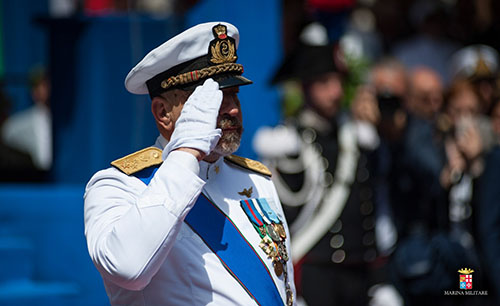 Admiral Giuseppe De Giorgi, chief of staff just grabbed the command rudder of the FA in December 2012, he immediately pointed out how the criticality of the times we are going through has imposed a series of difficult measures for the country involving the state military component in its structure. Nevertheless, the Navy interpreted and interpreted this moment as an opportunity for rational modernization of its organization. It is in fact the maritime vocation of our country that requires the Navy to be the guardian of national interests and of every type of external threat through a commitment of the personal component to rebuild a modern, reliable and ready-to-use organization that passes right from the restructuring. A central role is reserved for Cincnav, the Command in Head of the Naval Squadron (command and control) from the operational and management functions to the concentration of all information from the various naval forces. Centralization of functions also for the technical logistics with a special Command and a Command that deals with staff training, reduction of naval crews with new technology-intensive vehicles. The head of SM has personally followed the change of the new command line with the advent of a Logistical Command Northern Area (Northern Marina) with competences on the bases of the Upper Tyrrhenian Sea, of Sardinia, and of the Upper Adriatic, from the Marche to Venice.
Admiral Giuseppe De Giorgi, chief of staff just grabbed the command rudder of the FA in December 2012, he immediately pointed out how the criticality of the times we are going through has imposed a series of difficult measures for the country involving the state military component in its structure. Nevertheless, the Navy interpreted and interpreted this moment as an opportunity for rational modernization of its organization. It is in fact the maritime vocation of our country that requires the Navy to be the guardian of national interests and of every type of external threat through a commitment of the personal component to rebuild a modern, reliable and ready-to-use organization that passes right from the restructuring. A central role is reserved for Cincnav, the Command in Head of the Naval Squadron (command and control) from the operational and management functions to the concentration of all information from the various naval forces. Centralization of functions also for the technical logistics with a special Command and a Command that deals with staff training, reduction of naval crews with new technology-intensive vehicles. The head of SM has personally followed the change of the new command line with the advent of a Logistical Command Northern Area (Northern Marina) with competences on the bases of the Upper Tyrrhenian Sea, of Sardinia, and of the Upper Adriatic, from the Marche to Venice.
The rationalization of the logistics function, a function of a major state with a significant operational impact has already begun. A command will be responsible for supporting the fleet, replacing the division between maintenance logistics and logistics in general. Thus the Navy Chief of Staff will have three basic structures available: the Naval Team Command, Logistic Command with headquarters in Naples and the Command of the Schools based in Ancona. The lines of command, direction, control of military activities will be more marked with a saving of personnel and financial resources. In particular the Logistic Command in addition to being responsible for the lighthouse service and maritime signaling, for the safety of navigation, it will be the only interlocutor for the technical and logistical support of naval units, personnel and individual entities, with a peripheral structure that will transform territorial commands into commands area logistics. And this is how today the Navy has a new lean and efficient peripheral organization. The fleet will also have to be reduced and by this year 4 class frigates will be decommissioned Mistral, the 4 class patrol boats Soldiers, 6 corvette class Minerva , 3 minesweepers, 2 refuellers and other minor ships.
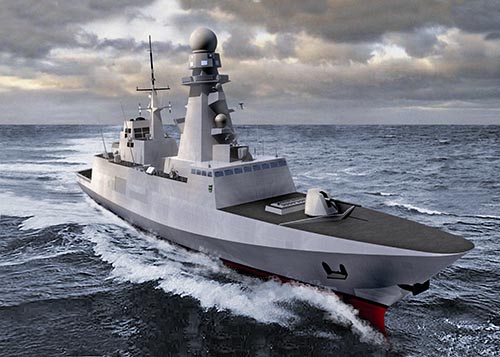 After the structural reorganization, a functional restructuring of the internal bureaucratic procedures (workflows) on which the final product is compared will therefore be needed, therefore we want to emphasize how this aspect must be continuously monitored and improved.
After the structural reorganization, a functional restructuring of the internal bureaucratic procedures (workflows) on which the final product is compared will therefore be needed, therefore we want to emphasize how this aspect must be continuously monitored and improved.
The ministerial dispositions that have profiled the reconfiguration of the Armed Forces in adherence to the changed geopolitical requirements, European and national have led unequivocally to a reduction of the personnel of the military and civil personnel.
Upstream decisions are also sought for reasons of public deficits, monetary balances, and consequently lower allocations for the Department of Defense. In principle it seems that this should be the closest answer to achieve results that can give rise to the financial sustainability of spending in the military sector. It is obvious that military public spending relates to the country's needs regarding the defense of Italy and its economic interests as well as compliance with the commitments made under international agreements and NATO. From the world scenario the role of our country has increasingly shifted the center of gravity towards security operations (peace keeping, p.enforcing, p.making p.building.) eliminating the primary role of co-belligerency of the armed forces, as admiral Bruno Branciforte, former Navy Chief of Staff during his past 2011 intervention at the Club Officers of Rome, on the occasion of the 135 anniversary of foundation of Commissariat body, with the presentation of the book "The Corps of Maritime Military Commissariat" (edited by Admiral Bruno Catozzi, of Admiral Antonio Sotgiu and other Corps officers). The text retracing the main historical stages of the Corps highlighted the evolution of the various sectors of employment, from administration, to naval and support logistics, to the legal sector, international law, etc. and it is in this context that Admiral Branciforte specified how the growth of FA's needs will soon lead to a revisitation of the unique figure of the naval officer who will have different specializations instead of the different bodies that currently characterize the organic and the use. These authoritative considerations allow us to reflect on the current dynamics of change and the need for reconfiguration of the military organization to which technical and legal supports must be provided that can broaden the decision-making framework to be submitted to military leaders. In this context it cannot fail to mention some perspectives that can lead to choices that favoring the final overall objective, do not make the basic element of the organization, the personnel and the relative employment, fail.
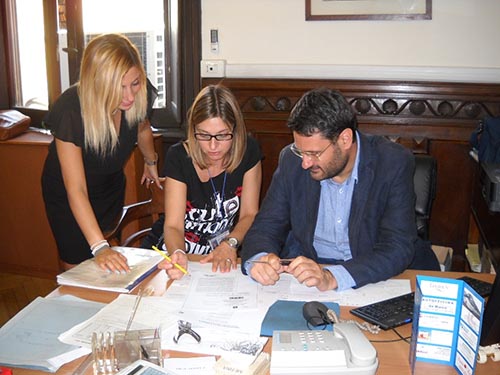 When we talk about reconfiguration we cannot ignore the fact that this can be implemented specifically with an accurate technical and legal analysis of the multiple activities that make up the organization of armed force, as well as the objective assessment of the skills and professionalism of military and civil personnel . In fact, reconfiguration as a synonym of modernization and economy, cannot be separated from evaluating the phases of process of activity and result in the light of advanced techniques of structural organization and ordered bureaucratic flow that are today at the base of the continuous remodeling of the international military world, economic and modern state machines. Themes particularly dear to the foresight and sensitivity of Admiral Leonardo Natale, then general office manager of the administrative responsibility center and head of Corps of Maritime Military Commissariat, (now replaced by the Deputy Sabino Imperscrutabile), which already since he held the office of head of legal affairs office of the major state he focused his attention on the themes of functional reorganization taking care of the technical legal aspects. In fact, these structural bases that make up the military organization become the combat post of the personnel to whom maximum attention must be given in terms of quality of work and profitability. Each individual must be given recognition of seniority of service, their experiences and professionalism consistent with the needs of the Armed Forces. It so happens that the professionalism of the military and civilian employee, its profitability, its performance and its seniority in absolute terms become more decisive, terms that in a review period of public expenditure (spending reviews) become essential with the continuous deductions of budget appropriations, to innovate and solve the needs that the organization continuously requires.
When we talk about reconfiguration we cannot ignore the fact that this can be implemented specifically with an accurate technical and legal analysis of the multiple activities that make up the organization of armed force, as well as the objective assessment of the skills and professionalism of military and civil personnel . In fact, reconfiguration as a synonym of modernization and economy, cannot be separated from evaluating the phases of process of activity and result in the light of advanced techniques of structural organization and ordered bureaucratic flow that are today at the base of the continuous remodeling of the international military world, economic and modern state machines. Themes particularly dear to the foresight and sensitivity of Admiral Leonardo Natale, then general office manager of the administrative responsibility center and head of Corps of Maritime Military Commissariat, (now replaced by the Deputy Sabino Imperscrutabile), which already since he held the office of head of legal affairs office of the major state he focused his attention on the themes of functional reorganization taking care of the technical legal aspects. In fact, these structural bases that make up the military organization become the combat post of the personnel to whom maximum attention must be given in terms of quality of work and profitability. Each individual must be given recognition of seniority of service, their experiences and professionalism consistent with the needs of the Armed Forces. It so happens that the professionalism of the military and civilian employee, its profitability, its performance and its seniority in absolute terms become more decisive, terms that in a review period of public expenditure (spending reviews) become essential with the continuous deductions of budget appropriations, to innovate and solve the needs that the organization continuously requires.
Logistics is a key to success
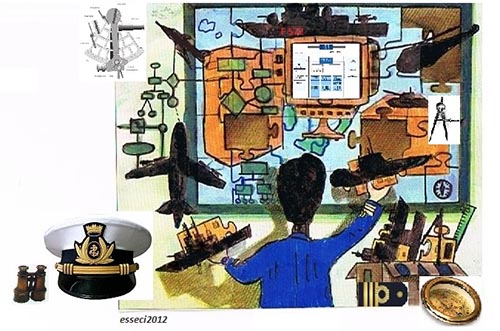 Logistics deals with the activities and organizational doctrines intended to assure the armed forces what is necessary to live, move and fight in the best conditions of efficiency and is one of the four branches of military art, with tactics, strategy and organic. Dealing with logistics is not easy, not so much for the complexity of the subject, as for the difficulty of attributing clear and well-defined application limits. It seems that it has now been definitively clarified what it is. The military restructuring of the Navy has given great prominence not only to the operational line but to the logistic organization that includes a series of support functions closely correlated with the use of the means. From this we can immediately see how different will be the problems that the logistics will have to face and resolve and we will understand why every FA has developed its own application concept of the discipline. We will see, however, that this situation is rapidly changing to give way to what could be defined as a common logistics concept, characterized by uniformity of application in the FF.AA. and high modularity, so as to be easily adapted to the specific military operation to be supported. The proposed change is the result of the changes that have taken place in the international reference scenario. At the risk of seeming to be taken for granted and not very original, the collapse of the Wall must be identified as an epochal turning point, following which NATO and, as a consequence, Italy, have had to revise their strategy and tasks. It has in a short time passed from a situation in which the threat, in its two salient features of consistency and origin, was well defined and known, to one in which none of these factors can no longer be said to be certain. We are now talking about the multi-directional nature of the threat and its unclear consistency, difficult to define a priori. The FF.AA. they immediately had to measure themselves with the new needs, deriving from the support given by the national policy to multinational companies, mainly in the UN but not only. This has resulted in a recent past, and it is reasonable to expect that it will lead to a future commitment by the FF.AA. in operations of a humanitarian nature in theaters also very distant from the Motherland with obvious logistic consequences. It is important to underline, in fact, how logistics evolves hand in hand with other branches of military art, strategy and tactics, and how it is to be considered, with respect to these, on an equal level. A single observation should be sufficient to give the logistics the right importance and relevance it deserves within the military world that often, especially in the national sphere, has snubbed it considering it a secondary and auxiliary discipline compared to others: the military plan strategically more ingenious and tactically conducted in the most unexceptionable way can fail, or achieve meager results, if it is not supported by a suitable logistic plan.
Logistics deals with the activities and organizational doctrines intended to assure the armed forces what is necessary to live, move and fight in the best conditions of efficiency and is one of the four branches of military art, with tactics, strategy and organic. Dealing with logistics is not easy, not so much for the complexity of the subject, as for the difficulty of attributing clear and well-defined application limits. It seems that it has now been definitively clarified what it is. The military restructuring of the Navy has given great prominence not only to the operational line but to the logistic organization that includes a series of support functions closely correlated with the use of the means. From this we can immediately see how different will be the problems that the logistics will have to face and resolve and we will understand why every FA has developed its own application concept of the discipline. We will see, however, that this situation is rapidly changing to give way to what could be defined as a common logistics concept, characterized by uniformity of application in the FF.AA. and high modularity, so as to be easily adapted to the specific military operation to be supported. The proposed change is the result of the changes that have taken place in the international reference scenario. At the risk of seeming to be taken for granted and not very original, the collapse of the Wall must be identified as an epochal turning point, following which NATO and, as a consequence, Italy, have had to revise their strategy and tasks. It has in a short time passed from a situation in which the threat, in its two salient features of consistency and origin, was well defined and known, to one in which none of these factors can no longer be said to be certain. We are now talking about the multi-directional nature of the threat and its unclear consistency, difficult to define a priori. The FF.AA. they immediately had to measure themselves with the new needs, deriving from the support given by the national policy to multinational companies, mainly in the UN but not only. This has resulted in a recent past, and it is reasonable to expect that it will lead to a future commitment by the FF.AA. in operations of a humanitarian nature in theaters also very distant from the Motherland with obvious logistic consequences. It is important to underline, in fact, how logistics evolves hand in hand with other branches of military art, strategy and tactics, and how it is to be considered, with respect to these, on an equal level. A single observation should be sufficient to give the logistics the right importance and relevance it deserves within the military world that often, especially in the national sphere, has snubbed it considering it a secondary and auxiliary discipline compared to others: the military plan strategically more ingenious and tactically conducted in the most unexceptionable way can fail, or achieve meager results, if it is not supported by a suitable logistic plan.
In the following tables nr. 1 and nr. 2 summarizes all the activities that changed the structural organization. Territorial and employment of the Navy.
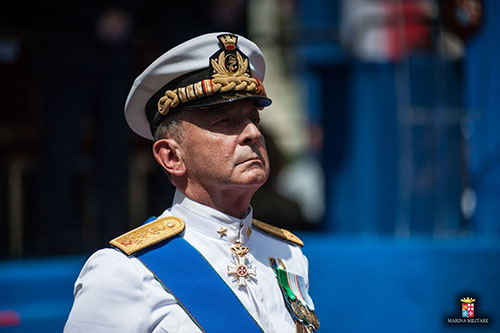 The challenge with the future will now be carried out under the guidance of Admiral Valter Girardelli, who in his introductory speech not only failed to break the commitment to continuity for efficiency and renewal of the aircraft instrument but thanks to its solid and profound professional and managerial experience has shown that this is not alone a need for defense and security, but a strong propulsive factor in the technological field, in industrial capacities, in the competitive positioning of the national system, in qualified work and in support of the creation and consolidation of strong and friendly international relations. Incisive and ambitious is the passage that the new chief of staff gave in front of the departments deployed at Palazzo Marina which summarizes the profiles of his future command action, "ONLY WHO HAS NO IDEAS DOES NOT CHANGE THEM". This challenge Admiral Girardelli wants to take it forward by involving all the military and civilian personnel of the Navy, so it will be useful to meditate on this spur, so that beyond the rituals of resignation and unproductive complaints often without solution, each of us takes the opportunity to reflect deeply on the contribution that can give to an organization that until now has given an example to emerge brilliantly even against all odds.
The challenge with the future will now be carried out under the guidance of Admiral Valter Girardelli, who in his introductory speech not only failed to break the commitment to continuity for efficiency and renewal of the aircraft instrument but thanks to its solid and profound professional and managerial experience has shown that this is not alone a need for defense and security, but a strong propulsive factor in the technological field, in industrial capacities, in the competitive positioning of the national system, in qualified work and in support of the creation and consolidation of strong and friendly international relations. Incisive and ambitious is the passage that the new chief of staff gave in front of the departments deployed at Palazzo Marina which summarizes the profiles of his future command action, "ONLY WHO HAS NO IDEAS DOES NOT CHANGE THEM". This challenge Admiral Girardelli wants to take it forward by involving all the military and civilian personnel of the Navy, so it will be useful to meditate on this spur, so that beyond the rituals of resignation and unproductive complaints often without solution, each of us takes the opportunity to reflect deeply on the contribution that can give to an organization that until now has given an example to emerge brilliantly even against all odds.
